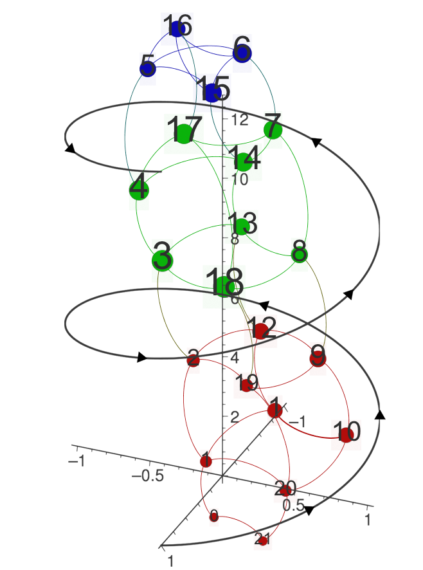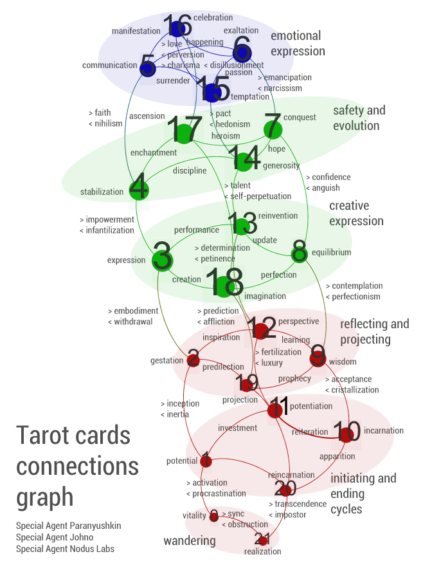Any divination is a system of interconnected reflections, each offering a unique perspective on things. Those reflections are aligned against each other in a very specific way – just like mirrors and prisms inside a photo camera – to produce the desired divinatory effect.
This application, created by agents Paranyushkin and Johnco, provides divinatory guidance for any situation that may arise. The best way to approach it is to think of a question and to then pick a random element for a reading. The reading is made to open up new perspectives and show directions for evolutionary development. Its API allows other applications to access the logic that is used at its core and provide recommendations that are based on a mix of similarity and serendipity.
The application is based on abstracted divinatory narrative structures extracted using network analysis (see full research and case study). Those structures are very efficient at their core. They form helix-like toroid network, which allows divination to replicate itself through evolutionary self-reiterations. Those go in waves and oscillations, bringing in the notions of evolution, cyclicality, opposition, change and diversity. Therefore, the reading itself promotes these same qualities for any question / situation that may arise and can provide an interesting perspective in this regard.

Most divinational narratives (Tarot, I Ching, Astrology, etc.) are built as a combination of linear and cyclical structures. The elements reveal and uncover themselves into a coherent linear unity that has a certain idea of evolution built in. At the same time all those elements along evolutionary path are interconnected, each bringing data to the current state from a different perspective. This produces basic feedback cyclical structures within the narrative opening it up for non-linear reading for divinatory advice. On the subjective level this structure seems to be “coherent” and have a “meaning” even if it does not make sense at first. What it promotes is the point of view, which is based from several different perspectives, each bringing multidimensionality to the current situation, connecting both cyclical and linear nature of time.

The basic structure of Tarot, for example, can be abstracted as an interconnected graph of 22 elements (major arcana cards), represented above. Every card has a connection to the card before (e.g. 7 < 8) and also to the card after (8 > 9) and chronological succession of cards follows a coherent narrative. However, 22 major arcana cards are also divided into two cycles: 1 to 10 and 11 to 20. Every card in one cycle is parallel to its mirror card in the other: 2 <> 12, 8 <> 18. As a result, reading one card automatically invokes another card from the other cycle. There is also a “complimentary” relation that activates the elements belonging to a completely opposite part of the linear narrative.

Therefore, on the basic level divination system can be seen as an efficient way of searching content: getting the most data from a corpus of interconnected elements with the minimum movement.
Read more about the methodology we use in our case study made with Nodus Labs: The Divination Network of Tarot.
Further reading: Divinatory Recommender Systems – between similarity and serendipity
Divinatorium is developed by Nodus Labs and Special Agency. You can contact us for more information, get your own Divinatory Kit or book a Divinatory Advice session.